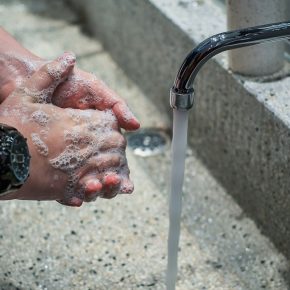
How to improve on-site health and safety measures
Health and safety are always at the forefront of the minds of responsible employers, but current times have perhaps made these issues even more prevalent, as this article explores…
In Europe, strict laws dictate how employers are responsible for ensuring a safe working environment and must continually be seeking to improve things.
With COVID-19 creating increased and new risks for all people in all shared places, including workplaces, additional measures are required.
Improving on-site health and safety, in relation to the virus, requires measures to enable social distancing – allowing staff to keep two metres apart where possible and one metre apart otherwise. Where that is not possible, such as in certain construction environments, additional steps are needed to mitigate risk.
As stated in the UK government’s ‘Working safely during coronavirus’ guidance, ways to improve on site health and safety in these times include:
Increasing the frequency of hand washing and surface cleaning
It is crucial that high levels of hand hygiene are maintained across teams. Providing antibacterial gels, dispensers and stations is one way to tackle this.
Not everyone can use those due to allergies or religious issues (given the gels contain alcohol). Additional portable hand wash stations are another potential solution.
Minimising the time spent on activities where social distancing is not possible
Businesses must consider activities that do not allow for social distancing; if they are key, the time spent on them should be kept to a minimum.
Employers need to ensure open dialogue with staff who may be at particular risk from the virus, and therefore at greater risk of carrying out non socially distanced activities.
Using screens or barriers to separate people from each other
Not only are solid perspex screens a potentially valuable source of protection against virus transmission during the current pandemic, they also act as a reminder and guideline for people.
Barriers can help to ensure people follow a one way system and avoid coming together in bottle neck areas, such as entrances and exits.
They also serve as a reminder to everyone to continue to maintain distancing. It is vital not to overlook break areas and canteens when enabling and signposting social distancing.
Reduce face-to-face working
Risks of COVID-19 transmission are reduced if face-to-face working and face-to-face communication is limited. Enabling and encouraging back-to-back or side-by-side working practices will work as a mitigating measure.
Create work team ‘bubbles’
Reducing the number of different people each individual comes into contact with will help reduce the risk of spreading should an incidence of the virus occur within the team.
This can be achieved by creating fixed teams and partnering systems to enable each person to only work directly with a few others.
Staggered breaks will help to enable this, when larger teams are all on site together. Staggering arrival and departure times or shifts are also considerations.
Other considerations
Improving health and safety on-site also requires thought around travel; whilst public transport firms, like Transport for London, are reiterating their own additional health and safety and hygiene measures, ensuring teams have choices about how to get to work to minimise risk will also help to improve safety for them and colleagues at work.
Measures such having ample parking spaces and bike racks will help provide options other than public transport for travel to work.
If van travel is necessary, thorough and regular cleaning of vehicles is vital, as is considering leaving seats empty to allow for social distancing.
Security keypads may need to be rethought to maintain security, but reduce the need for regular touching of the same surfaces.
Furthermore, supporting employees to wear face masks is also advisable.
Latest news

26th July 2024
Enfield Speciality Doors completes world-class project for Atlas Copco HQ
A rundown office and warehouse building completely transformed into a modern headquarters for Atlas Copco has been fitted with more than 120 internal fire doors from Enfield Speciality Doors.
Posted in Access Control & Door Entry Systems, Articles, Building Industry News, Building Products & Structures, Building Systems, Case Studies, Doors, Interior Design & Construction, Interiors, Posts, Restoration & Refurbishment, Retrofit & Renovation, Security and Fire Protection, Sustainability & Energy Efficiency, Timber Buildings and Timber Products, Wooden products
26th July 2024
Abloy UK launches new white paper
Abloy UK, a leading provider of security and access control solutions, has launched a new white paper.
Posted in Access Control & Door Entry Systems, Architectural Ironmongery, Articles, Building Industry News, Building Products & Structures, Building Services, Doors, Facility Management & Building Services, Health & Safety, Information Technology, Innovations & New Products, Publications, Research & Materials Testing, Security and Fire Protection
26th July 2024
MCRMA Member Profile: David Roy, Director of Roofconsult
David Roy of MCRMA member company Roofconsult has more than 50 years’ experience to draw upon working in the building envelope sector and a unique perspective on how it has changed in that time.
Posted in Articles, BIM, Infrastructure & CAD Software, Building Associations & Institutes, Building Industry News, Building Products & Structures, Building Services, Building Systems, Cladding, Information Technology, Restoration & Refurbishment, Retrofit & Renovation, Roofs, Walls
26th July 2024
Strand: Enhancing Door Functionality and Safety
Craig Fox, Sales Director for Strand Hardware, outlines how door industry professionals might apply door limiting stays…
Posted in Architectural Ironmongery, Articles, Building Industry News, Building Products & Structures, Building Services, Doors, Facility Management & Building Services, Health & Safety, Restoration & Refurbishment, Retrofit & Renovation
 Sign up:
Sign up: